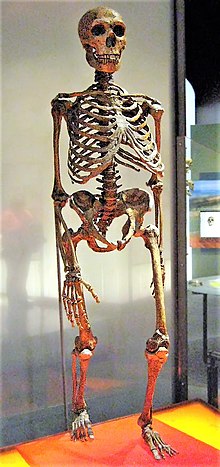
Neanderthal anatomy differed from modern humans in that they had a more robust build and distinctive morphological features, especially on the cranium, which gradually accumulated more derived aspects, particularly in certain isolated geographic regions. This robust build was an effective adaptation for Neanderthals, as they lived in the cold environments of Europe. In which they also had to operate in Europe's dense forest landscape that was extremely different from the environments of the African grassland plains that Homo sapiens adapted to with a different anatomical build.
Anatomical evidence suggests they were much stronger than modern humans[1] while they were 12-14cm shorter on average than post World War II Europeans, but as tall or slightly taller than Europeans of 20 KYA:[2] based on 45 long bones from at most 14 males and 7 females, height estimates using different methods yielded averages in the range of 164–168 cm (65–66 in) for males and 152 cm (60 in) for females.[2] Samples of 26 specimens in 2010 found an average weight of 78–83 kg (172–183 lb) for males and 63–66 kg (139–146 lb) for females,[3] giving a considerably higher average BMI than H. sapiens. A 2007 genetic study suggested some Neanderthals may have had red hair.[4][5]
Neanderthal teeth also serve as a point of recognition in their anatomy. This is because Neanderthal teeth illustrate non-primitive accounts, and different frequencies when in comparison to modern humans. The research behind Neanderthal teeth morphology shows that it is a unique characteristic and evolutionary trait specifically only found within Neanderthals.[6]
- ^ "Neanderthal". BBC. Archived from the original on 31 May 2010. Retrieved 18 May 2009.
- ^ a b Helmuth, H. (1998). "Body height, body mass and surface area of the Neandertals". Zeitschrift für Morphologie und Anthropologie. 82 (1): 1–12. doi:10.1127/zma/82/1998/1 (inactive 9 March 2024). ISSN 0044-314X. JSTOR 25757530. PMID 9850627.
{{cite journal}}: CS1 maint: DOI inactive as of March 2024 (link) - ^ Froehle AW, Churchill SE (2009). "Energetic Competition Between Neandertals and Anatomically Modern Humans" (PDF). PaleoAnthropology: 96–116. Retrieved 12 September 2022.
- ^ Lalueza-Fox C, Römpler H, Caramelli D, Stäubert C, Catalano G, Hughes D, et al. (November 2007). "A melanocortin 1 receptor allele suggests varying pigmentation among Neanderthals". Science. 318 (5855): 1453–1455. Bibcode:2007Sci...318.1453L. doi:10.1126/science.1147417. PMID 17962522. S2CID 10087710.
- ^ Rincon P (25 October 2007). "Neanderthals 'were flame-haired'". BBC News. Retrieved 25 October 2007.
- ^ Cite error: The named reference
:4was invoked but never defined (see the help page).
© MMXXIII Rich X Search. We shall prevail. All rights reserved. Rich X Search
